The haunting call of the Northern Bobwhite once echoed across Ontario’s grasslands, but today, these iconic birds face a critical struggle for survival. As their populations decline by over 80% in the past four decades, local communities are rallying together to protect these charismatic ground-dwellers through innovative conservation initiatives.
Nestled between farmlands and forest edges, quail require a delicate mosaic of habitats to thrive – from native grasslands for nesting to shrubby areas for winter shelter. Their decline tells a larger story about the health of our shared ecosystems and the pressing need to preserve Ontario’s natural heritage.
Yet there’s hope on the horizon. Through collaborative efforts between landowners, conservation groups, and citizen scientists, successful quail restoration projects are breathing new life into previously silent fields. These initiatives not only benefit quail but also support countless other species that depend on grassland habitats, from beneficial insects to songbirds.
As we stand at a crucial crossroads for quail conservation, every action counts – whether it’s participating in habitat restoration, supporting local conservation initiatives, or simply spreading awareness about these remarkable birds. Their future depends on the choices we make today, and the legacy we choose to leave for tomorrow’s generations.
Why Quail Matter to Ontario’s Ecosystem
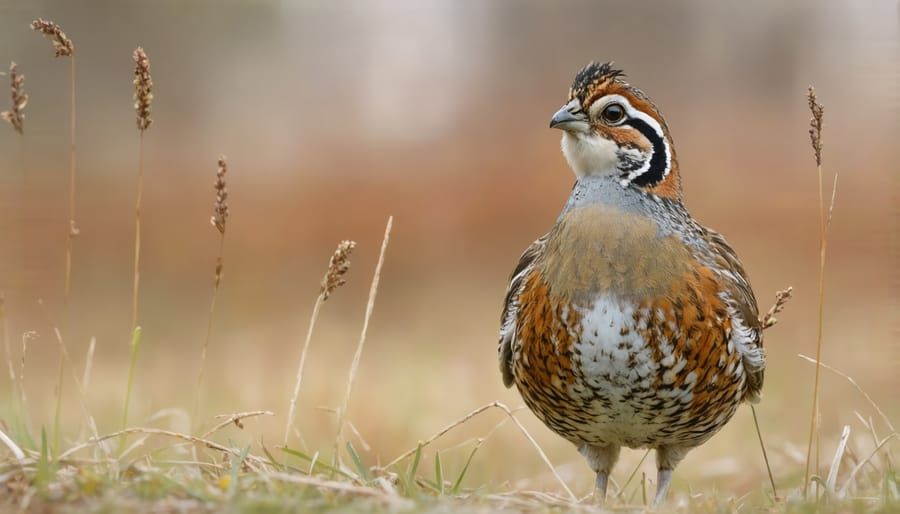
Local Biodiversity Benefits
Quail play a vital role in maintaining the delicate balance of Ontario’s ecosystems. These charming ground-dwellers are nature’s cleanup crew, feeding on potentially problematic insects and helping to control weed populations through their seed-eating habits. When quail populations thrive, they contribute to ongoing biodiversity mapping efforts that help scientists understand the health of our local environments.
As both predator and prey, quail occupy a crucial middle position in the food chain. They provide sustenance for larger predators like foxes and hawks while keeping insect populations in check. Their presence often indicates a healthy ecosystem, as these birds require diverse plant life and specific habitat conditions to flourish.
What’s particularly fascinating is how quail support plant diversity through seed dispersal. As they move through their territory, they spread seeds from native plants, helping maintain the natural vegetation that other wildlife depends on. Their scratching behavior also helps aerate the soil, creating better growing conditions for local plant species.
For gardeners and farmers, having quail nearby can be a natural form of pest control, as they eagerly feast on troublesome insects that might otherwise damage crops or garden plants.
Cultural Heritage Connection
The Northern Bobwhite quail has been woven into Ontario’s cultural fabric for generations, playing a significant role in both Indigenous and settler communities. For First Nations peoples, these charismatic birds were not only an important food source but also featured prominently in traditional stories and teachings about environmental stewardship. Their distinctive “bob-white” call once served as nature’s alarm clock for farming families across rural Ontario, marking the changing of seasons and agricultural rhythms.
Local hunters have long considered the pursuit of quail a time-honored tradition, passing down hunting ethics and conservation values through generations. Many old-timers still reminisce about times when coveys of quail were a common sight in farm fields and meadow edges. Their stories often highlight how agricultural practices and community life were once naturally aligned with quail habitat preservation.
Today, this rich heritage fuels many conservation initiatives, as communities work to ensure future generations can experience the joy of hearing a bobwhite’s whistle across Ontario’s countryside. Through educational programs and community events, conservationists are keeping these cultural connections alive while inspiring new generations to become stewards of our natural heritage.
Community-Led Conservation Success Stories
The Frontenac Initiative
In the heart of Ontario’s Frontenac region, a remarkable grassroots movement has taken root to protect and restore the local bobwhite quail population. What began as a small initiative by concerned residents has blossomed into a comprehensive conservation success story, drawing support from local conservation groups and community members alike.
The initiative kicked off in 2018 when longtime Frontenac resident Sarah Thompson noticed a declining quail population on her family farm. She rallied neighboring landowners and organized community workshops to educate people about creating quail-friendly habitats. Within months, dozens of property owners had committed to maintaining edge habitats and implementing wildlife-friendly farming practices.
Today, the Frontenac Initiative serves as a shining example of community-driven conservation. Participating landowners have restored over 500 acres of quail habitat by planting native grasses and maintaining brush piles. Local schools have joined the effort, with students helping to monitor quail populations and maintain feeding stations during harsh winter months.
The results speak for themselves: recent surveys show a 40% increase in bobwhite quail numbers across the region. Visitors can now enjoy guided “quail walks” during spring and summer months, while photographers flock to the area to capture these charismatic birds in their natural habitat. The initiative has become a blueprint for other Ontario communities looking to protect their local wildlife.
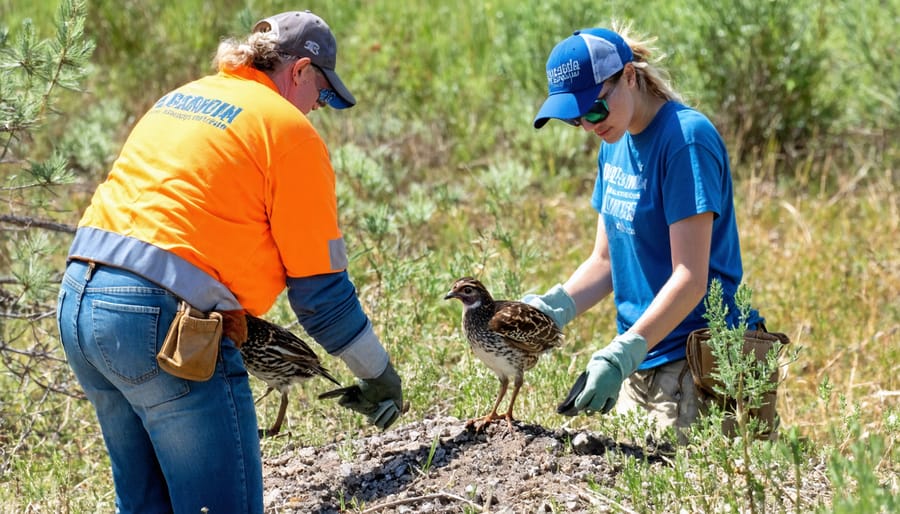
Local School Programs
Young minds are leading the charge in quail conservation across Ontario, with schools embracing hands-on learning opportunities that connect students with local wildlife. At Pine Ridge Elementary, students participate in the “Quail Guardians” program, where they help maintain native plant gardens that provide essential habitat for local quail populations.
The “Classroom to Conservation” initiative, running in over 20 schools across the province, lets students raise quail chicks under supervision, teaching them about wildlife care and habitat requirements. These young conservationists monitor growth, document behaviors, and ultimately participate in supervised releases into protected areas.
Students at Maple Grove Middle School have created an impressive “Quail Watch” citizen science program, where they use mobile apps to track and report quail sightings in their community. Their data helps local conservation authorities monitor population trends and movement patterns.
Several high schools have integrated quail conservation into their environmental science curriculum. Students learn about ecosystem management while getting hands-on experience building nesting boxes and planting native species that support quail populations.
These programs aren’t just educational – they’re creating the next generation of conservation leaders. Many students continue their involvement through volunteer work and even pursue careers in wildlife management. As one teacher notes, “When kids connect with wildlife at a young age, they become lifelong advocates for conservation.”
How Visitors Can Support Quail Conservation
Responsible Wildlife Viewing
When observing quail in their natural habitat, remember that these charming birds are easily startled. Keep your distance – about 50 meters is ideal – and bring a good pair of binoculars for the best viewing experience. Early morning and late afternoon are prime times to spot quail, as they’re most active during these hours.
Stay on marked trails to avoid disturbing nesting areas and feeding grounds. If you’re lucky enough to spot a covey (group of quail), remain still and quiet. They’ll often continue their natural behaviors if they don’t feel threatened. Consider wearing earth-toned clothing to blend in with the environment.
Photography enthusiasts should use zoom lenses rather than trying to get too close. Avoid using flash photography, which can startle not just quail but other wildlife as well. Never bait or feed wild quail – this can make them dependent on human food and less capable of surviving on their own.
If you’re bringing kids along, make it a fun learning experience by teaching them to spot quail tracks or listen for their distinctive calls. Remember to pack out what you pack in, and keep your voice low to minimize disturbance to these wonderful birds and their habitat.
Volunteer Opportunities
Getting involved in quail conservation is easier than you might think! Throughout Ontario, there are numerous opportunities to make a real difference in protecting these beloved ground-dwelling birds. Local conservation groups regularly organize habitat restoration events where volunteers help plant native grasses and shrubs that quail need to thrive.
The Ontario Federation of Anglers and Hunters (OFAH) runs seasonal volunteer programs where you can assist with quail population surveys and habitat assessments. These citizen science initiatives are perfect for both beginners and experienced nature enthusiasts.
Consider joining the Quail Forever Ontario Chapter, where you’ll connect with fellow conservation advocates and participate in hands-on projects. They organize regular weekend workdays throughout the spring and summer months, making it convenient for both local residents and visitors to pitch in.
For those who can’t commit to regular volunteering, there are one-time events like the annual Quail Count Day, where volunteers spend a morning recording quail sightings in their area. It’s a fantastic way to contribute while enjoying Ontario’s beautiful outdoors!
To get started, reach out to your local conservation authority or provincial park. They’ll connect you with ongoing projects and upcoming volunteer opportunities in your area.
Creating Quail-Friendly Spaces
Native Plant Gardens
Creating a native plant garden is one of the most rewarding ways to support local quail populations. These beautiful birds thrive in areas with diverse vegetation that provides both food and shelter. Start by incorporating native grasses like switchgrass and little bluestem, which offer excellent cover for quail throughout the year.
Berry-producing shrubs such as elderberry, serviceberry, and wild rose are perfect additions to your garden. These plants not only provide essential food sources but also create natural hiding spots for quail families. Consider adding flowering plants like black-eyed susans, coneflowers, and goldenrod, which attract insects – a crucial protein source for young quail.
For best results, plant in clusters rather than straight rows. This mimics natural growth patterns and creates the kind of protective corridors quail prefer when moving between feeding areas. Leave some open spaces between plantings, as quail need bare ground for dust bathing and foraging.
Remember to avoid using chemical pesticides in your garden, as these can harm both the quail and their insect food sources. Instead, embrace natural pest control methods and let your garden develop into a mini ecosystem. During winter, resist the urge to clear away dead plant material – it provides essential shelter and foraging opportunities when food is scarce.
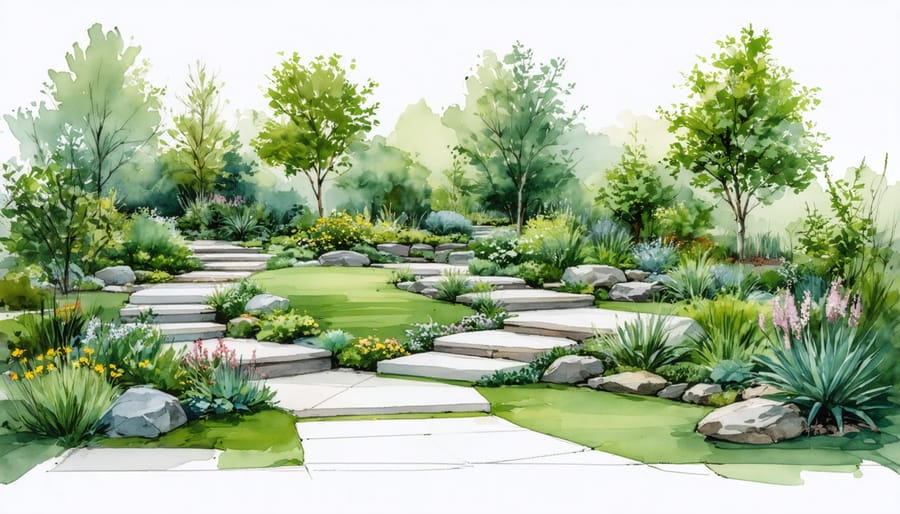
Habitat Protection Tips
Every landowner and outdoor enthusiast can play a vital role in quail conservation. Start by maintaining diverse vegetation on your property – quail thrive in areas with a mix of native grasses, shrubs, and open spaces. Leave some brush piles and fallen logs in place, as these provide essential cover from predators and harsh weather.
Consider dedicating a portion of your land to wildflowers and native plants, creating natural feeding grounds for these ground-dwelling birds. When mowing, maintain heights of at least 6-8 inches and avoid disturbing nesting areas during breeding season (April through August).
If you’re passionate about protecting native habitats, remove invasive plant species that can overtake quail-friendly vegetation. Create buffer strips along field edges and maintain existing fence rows, which provide travel corridors and escape cover.
For smaller properties, even a modest garden can help by including native seed-producing plants. Avoid using chemical pesticides near quail habitats, as these can harm both the birds and their insect food sources. Remember, connecting fragmented habitats through coordinated efforts with neighbors can create larger, more sustainable areas for quail populations to thrive.
The future of quail conservation in Ontario rests in the hands of our community, and together, we can make a remarkable difference. From backyard birders to farmers, every individual plays a vital role in protecting these cherished ground-dwelling birds. The success stories we’ve witnessed across the province prove that when communities come together, quail populations can bounce back and thrive.
You don’t need to be a wildlife expert to contribute to quail conservation. Simple actions like maintaining natural field edges, delaying hay cutting until after nesting season, or participating in citizen science programs can have a lasting impact. Consider joining local conservation groups, attending wildlife workshops, or volunteering for habitat restoration projects in your area.
For families, quail conservation offers wonderful opportunities to connect with nature and teach younger generations about wildlife stewardship. Whether it’s building quail-friendly gardens or participating in annual bird counts, these activities create meaningful experiences while supporting conservation efforts.
The time to act is now. Our feathered friends need our help, and every small step counts. Share your knowledge with neighbors, support local conservation initiatives, and stay informed about quail-friendly practices. By working together and staying committed to protecting these beautiful birds, we can ensure that future generations will continue to enjoy the distinctive call of quail across Ontario’s landscapes.
Remember, conservation success depends on community participation – your involvement makes all the difference!

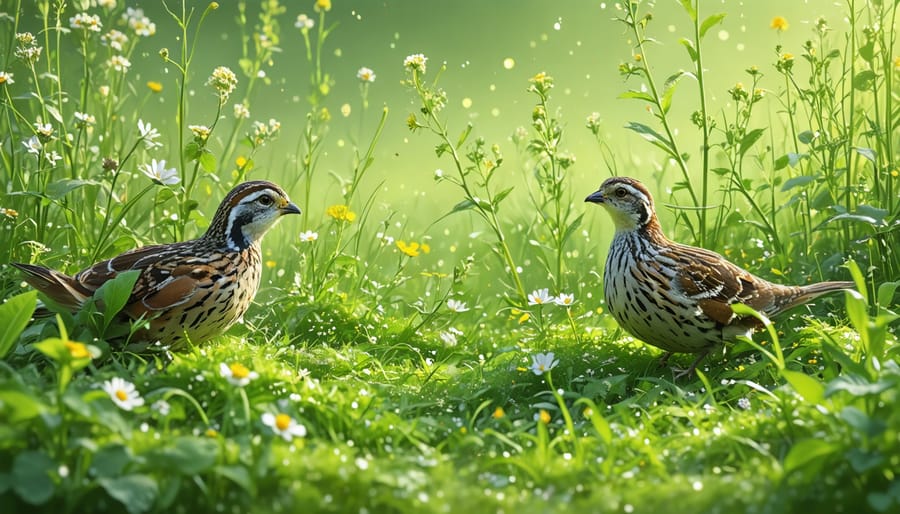

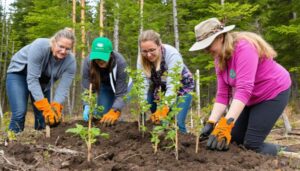
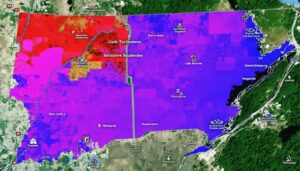




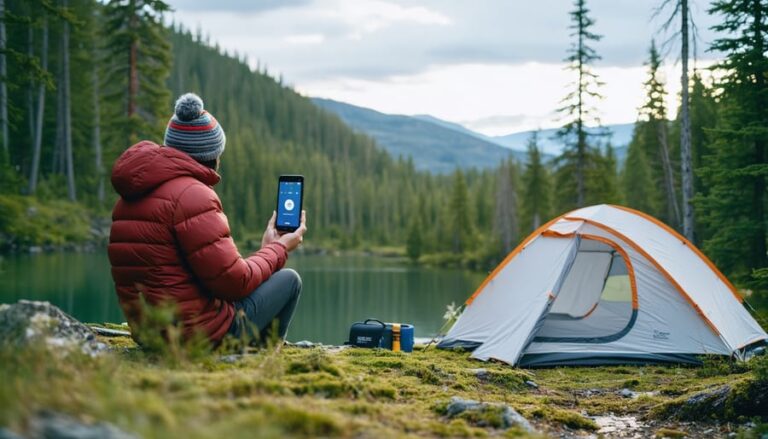

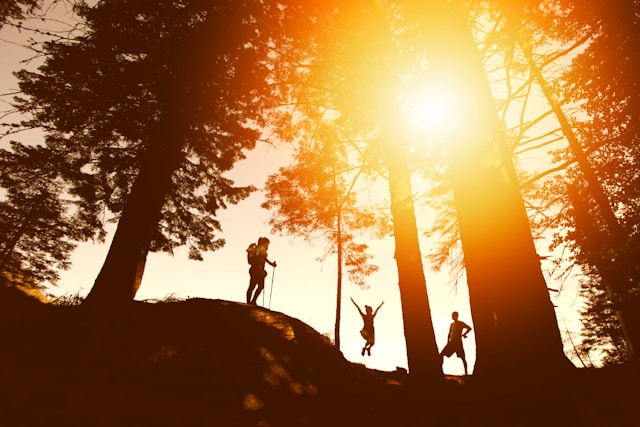
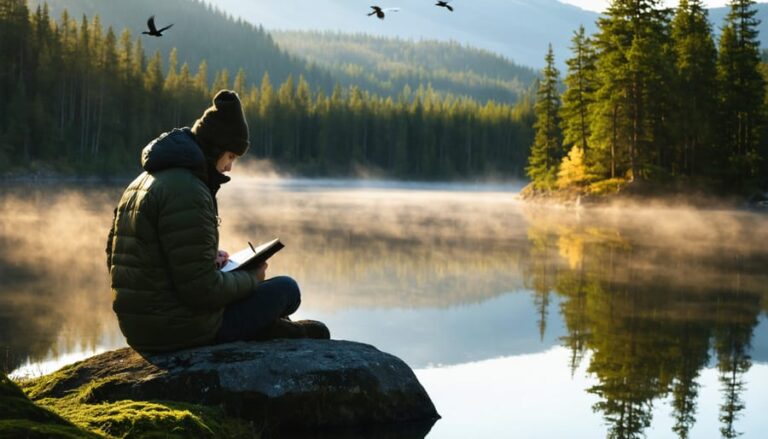
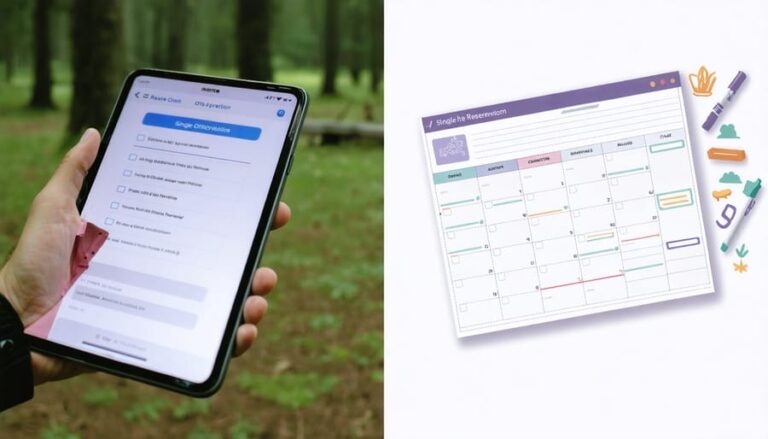
+ There are no comments
Add yours